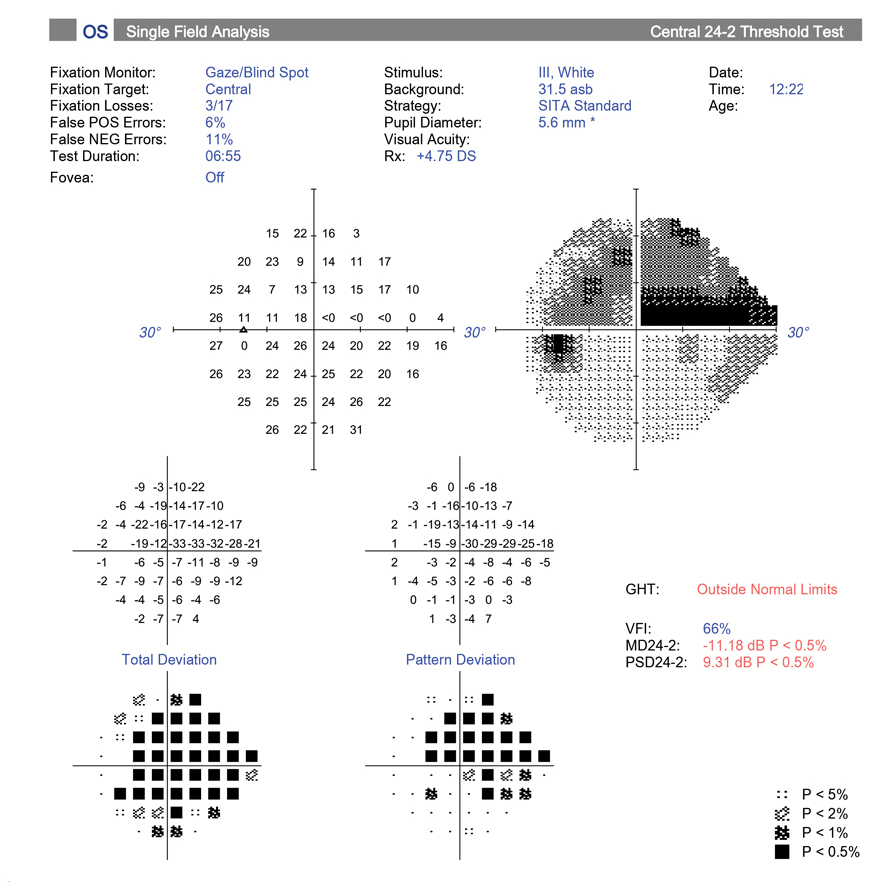 |
| Glaucoma was ranked as the second leading cause of blindness (after cataract) and fourth leading cause of moderate or severe vision loss, and therefore the most common cause of irreversible blindness, and the second most common cause of irreversible moderate or severe vision loss. This highlights the importance of glaucoma as a public health concern. Photo: Michael Chaglasian, OD, and Sarah B. Klein, OD. |
It’s rare to encounter any good news in the epidemiology of age-related eye disease but a new analysis of glaucoma prevalence offers a silver lining to this otherwise distressing and intractable condition: Between 2000 and 2020, global age-standardized prevalence of glaucoma-related blindness among adults ≥ 50 years decreased by 26.1% among men and by 21.8% among women. Over this same period, however, moderate or severe vision loss due to glaucoma increased by 3.7% among men and by 7.3% in women.
Moderate or severe vision loss was defined as visual acuity of 6/60 or better but <6/18 (moderate) and visual acuity of 3/60 or better but <6/60 (severe vision loss). Blindness was defined as presenting visual acuity <3/60.
Globally, in 2020, 3.61 million people were blind and nearly 4.14 million were visually impaired by glaucoma. The disease accounted for 8.4% of all blindness and 1.4% of all moderate or severe vision loss. Glaucoma was ranked as the second leading cause of blindness (after cataract) and fourth leading cause of moderate or severe vision loss, and therefore the most common cause of irreversible blindness, and the second most common cause of irreversible moderate or severe vision loss.
Regionally, the highest proportion of blindness relating to glaucoma was found in high-income countries, while the region with the highest age-standardized prevalence of glaucoma-related blindness and visual impairment was Sub-Saharan Africa.
“Bucking this trend were the regions of North Africa and Middle East and Sub-Saharan Africa, both with younger populations than the median global age but with a relatively high contribution of glaucoma to blindness, most probably on account of these regions having the highest age-standardized prevalence of glaucoma-related blindness,” the researchers explained in their paper for the journal Eye. “Glaucoma causes a particular challenge as many low- and middle-income countries experience these demographic changes. Due to the typically lengthy asymptomatic phase, it is well documented that in high-income countries, less than half of glaucoma is diagnosed. In low- and middle-income countries, this proportion increases to over 90% and approximately 35% of patients are estimated to be blind at diagnosis. Furthermore, the higher prevalences on the African continent are almost certainly due in part to lack of or insufficient access to treatment.”
The data presented in this analysis “suggests a triaging phenomenon: although efforts to contain glaucoma blindness have had some success, the availability of current resources is not meeting the demands at visually significant but lower thresholds of visual impairment,” the authors concluded. “The observed increase in glaucoma-related moderate or severe vision loss may be interpreted as an improvement if more cases are detected at an earlier stage before the onset of blindness.”
Vision Loss Expert Group of the Global Burden Study and the GBD 2019 Blindness and Vision Impairment Collaborators. Global estimates on the number of people blind or visually impaired by glaucoma: a meta-analysis from 2000 to 2020. April 2, 2024. [Epub ahead of print.] |


